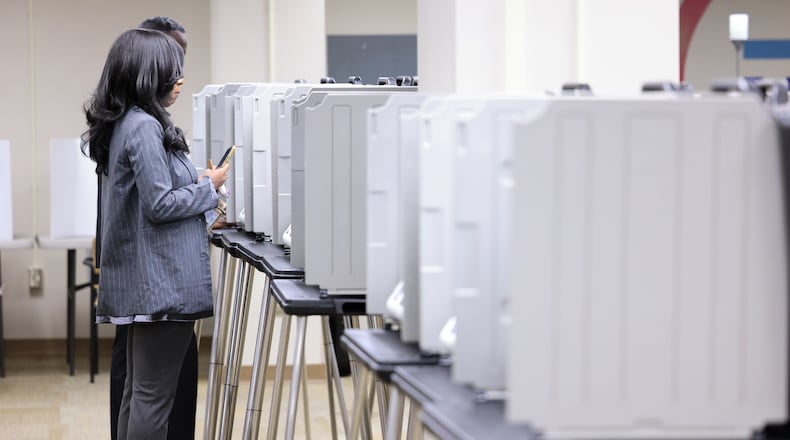Here’s everything voters need to know ahead of casting a ballot:
Voting options
There will be no voting at election board offices on Monday, but voters who want to cast their ballots in person can do so at their assigned polling locations on Tuesday. Voters can find their polling locations at VoterLookup.OhioSoS.gov or through their election board’s website.
Voters who received an absentee ballot from their election board have until Monday to mail it. Ballots need to be postmarked by Monday, Nov. 3. Ballots sent to election boards by mail will need to arrive by Saturday, Nov. 8.
If voters have a filled-out ballot and miss this mail-in deadline, they can drop off the ballot in person at the election board office or at their county ballot drop box. The board of elections must receive these ballots no later than 7:30 p.m. on Election Day.
What you need to vote
Voters wanting to cast a ballot in person should ensure they bring an unexpired photo ID to the polls to comply with Ohio’s voter ID law.
Valid forms of identification include an Ohio driver’s license, a U.S. passport or passport card, a state of Ohio ID card, an interim ID form issued by the Ohio Bureau of Motor Vehicles, a U.S. military ID card, an Ohio National Guard ID card, or a U.S. Department of Veterans Affairs ID card.
All ID cards must be unexpired, have a photograph of the voter and include the voter’s name as it appears on the poll list.
People who show up to vote in-person who lack the proper ID are asked to vote provisionally. They must return to their election board office with a valid photo ID by Saturday, Nov. 8 to have their vote counted.
Ohio state ID cards are free to people 17 and older. In order to obtain a state ID card, applicants must provide proof of their full legal name, date of birth, Social Security number, citizenship and Ohio street address.
Local leadership
There are nearly 70 local city, village and township races on the ballot in Montgomery, Greene, Miami and Warren counties, including several contested mayor races, and city commission races that will determine control of a few area cities.
In Dayton, Mayor Jeffrey Mims Jr. faces off with Commissioner Shenise Turner-Sloss. Each is running on a slate with two other commission candidates.
In Kettering, councilmembers Bob Scott and Bryan Suddith are vying for mayor. Mayor Peggy Lehner is not running for reelection. Kettering also has three candidates running for two city council seats — Laura Arber, Dan Palmer and Tyler Scott.
In Moraine, Mayor Teri Murphy faces challenger and former councilwoman Erica Watts.
In Greene County, races to watch include the Beavercreek city council race (with Ed Maloof, Glenn Duer, Sarah Bills, Zach Upton and Tiffany Schwartz running for three open seats) and the Yellow Springs mayoral race between Steve McQueen and Mark Heise. Another six candidates are vying for three open seats on Yellow Springs’ city council.
And races for area boards of education are among the most competitive in Tuesday’s election, with seven or more candidates vying for three or four open seats on school boards in Montgomery, Greene, Butler and Clark counties.
Races for boards of education seats at Centerville City Schools, Dayton City Schools, Mad River Local School District, Oakwood Schools, Miamisburg Schools, Vandalia-Butler Schools and the Montgomery County Education Service Center are all contested, representing 37 candidates vying for 25 open seats.
In Greene County, five candidates are vying for three seats on the Beavercreek City School Board, and another seven candidates hope to win one of three seats on Xenia School Board.
Tax issues
Ballot issues will vary depending on where a voter lives, but Montgomery, Greene and Miami County voters will have countywide issues on their ballots.
Voters in November will be asked to renew Montgomery County’s 8-year, 6.03-mill Human Services Levy, which funds $58 million in social services. This renewal comes with no increases to taxes that homeowners are already paying.
Similarly, in Greene County, a 5-year, 0.8-mill public health levy renewal will also be on the ballot.
And Greene County Public Libraries is asking voters to consider passing a new 1-mill, 10-year property tax levy to fund library materials, operations, programs and services. The library last passed an operating levy in 2014.
In Miami County, voters have been asked since the 1950s to approve a bridge levy every five years. This fall, they’ll be asked to approve that levy becoming permanent.
A dozen school districts in the region also have tax issues on the ballot. In Ohio, anywhere from 60% to 80% of a county’s property taxes go to its schools.
Jefferson Twp. Local Schools is asking for a three-year, 1% income tax that would generate just under $1 million per year for the district.
The district, which has been in deficit spending for the last eight years, is at risk of being in financial oversight from the state if the levy does not pass. The district’s entire budget was about $8.3 million last school year, and this school year is projected to be about $8.5 million.
Lower, slower voter turnout
Elections that follow a presidential or gubernatorial year typically see turnout percentages of registered voters in the high teens or low 20s, except in some communities with controversial tax issues.
According to the Ohio Secretary of State’s Office, nearly 160,000 voters turned in their ballots or voted early in person one week out from the election. That includes tens of thousands of voters in southwest Ohio.
Ohio has roughly 8 million registered voters.
About the Author

